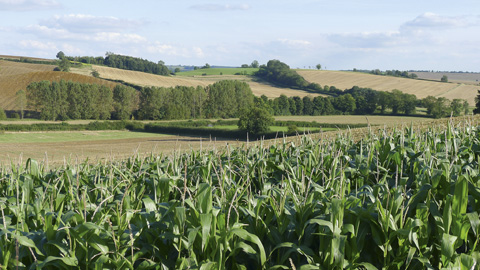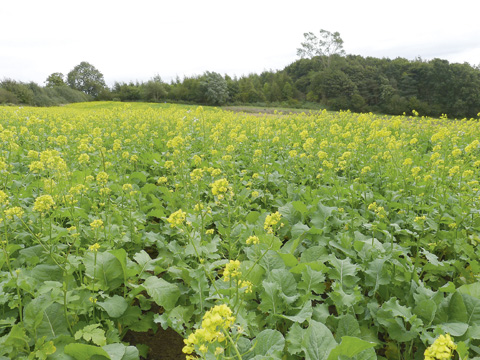Kings Cover Crops: Expert advice from Richard Barnes

Since the beginning of 2012, Kings Game Cover and Conservation Crops has been working with the Game and Wildlife Conservation Trust’s (GWCT) Allerton Project. The primary aim of the partnership is to develop game cover crops and stewardship crops at the picturesque Leicestershire farm, which was left to the trust by Lord and Lady Allerton.
Having personally spent time working alongside gamekeeping guru Malcolm Brockless at the Allerton Project during the 1990s, I was delighted to embark on this particular partnership. The early years saw the team at Allerton implement effective game and habitat management that delivered significant rewards in terms of increased numbers of wild pheasants, brown hares and numerous songbird species. There then followed a monitoring period when vermin control and supplementary feeding were both withdrawn – with an obvious effect on the farm’s wildlife.
A return to shooting
Two years ago this plan of action was reversed, with the team at Allerton seeking to build on what was learnt in the early days and prove that good game-management practice will also deliver results that benefit the farmland environment.
Our remit since early 2012 has been to increase food sources and cover crops for wildlife by introducing a range of mixtures and new habitats. For the first time in a number of years, Loddington also employed a gamekeeper, James Watchorn. A combination of wild and released game now provides a programme of high quality driven shooting throughout the winter. All of this has heralded the start of a new chapter in the project’s history.
Making the right choice of cover crops
Loddington provides an excellent demonstration site for integrated farm management. It is based on a 328-hectare working farm that has some of Leicestershire’s finest heavy clay; although 2012 probably wasn’t the best year to start a new crop establishment programme!
It quickly became clear that the habitat improvement work undertaken over the last 21 years required development in order to meet the needs of the shoot’s programme as well as the farm’s Environmental Stewardship commitments. The first step was to work with James and farm manager Phil Jarvis to identify opportunities to encourage wild game, retain existing stock on the farm and ensure the correct driving cover was available in the right places for shoot days.
Previously, maize had been used as a key feed and cover crop. While this was still an important element of the cover crop chosen, we also needed to demonstrate and innovate. So we decided to reduce the maize area and replace it with a range of other crop types. Providing continuity of cover crops was important, but we were keen to avoid over-complicating the conservation cropping plan and to reduce any establishment risk.
Two-year cover crops
To ensure adequate weed control, we partnered crops with corresponding herbicide programmes. A blend of Coleor, 1,000 head and Goldeneye kale was planted alongside Kings’ Moir Mix (containing kale, kale rape, fodder radish, linseed, gold of pleasure and phacelia). This provided a beneficial mix of feed and varied cover – a combination favoured by game birds. A pre-emergence broadleaved weed herbicide was then applied, which helped establishment, followed by post-emergence application to control creeping thistle.
 Kings’ Moir Mix – which contains kale, fodder radish, linseed and more – and a kale blend planted in adjacent strips have stood the winter well and have the potential to last two years.
Kings’ Moir Mix – which contains kale, fodder radish, linseed and more – and a kale blend planted in adjacent strips have stood the winter well and have the potential to last two years.
A further benefit of introducing this plant combination is that many of the strips can be retained for a second year. A site visit in February allowed us to review each plot and decide which areas could be kept and which should be re-planted. This technique helps to provide valuable continuity of cover crops, reduce establishment costs and allow more time to concentrate on planting new crops through the spring period.
One-year cover crops
The second pairing was a combination of maize strips alongside a cereals-based wild bird-seed mixture. Campaign Mix contains triticale, barley, linseed, red, white and reed millet. This has been a good partner to the taller maize crop, as it provides a low-level wind break as well as a food source. Again, a weed control option was available, with both crops tolerant of certain key broadleaved weed herbicides. Although this combination only offers benefit for one year, the fact brassica-based crops are planted elsewhere means that spring mowing and ploughing can take place without compromising cover or food availability.
Tangled canopies and financial gains
Wherever possible, each block of cover had a three-metre perennial mix planted along its edge. The mix of Coleor kale, gold of pleasure, phacelia, lucerne, sweet clover, chicory and reed canary grass has supplied good hardy winter cover crops and can be left in place for several years. The resulting tangled canopy will provide vital hedgerow structure on exposed plots, which will keep numerous species safe from overhead predation as well as supply nesting and potentially brood-rearing opportunities during spring and summer. As the canopy hardens off through the autumn and winter, these strips then supply shelter and driving cover. It’s a versatile crop that adds year-round benefits for several seasons.
 Winter hardy, summer sown catch crops saved the day in one or two key areas.
Winter hardy, summer sown catch crops saved the day in one or two key areas.
The use of such wild bird seed mixtures within the HLS has also brought notable financial benefits to the farm business at Loddington. Land planted with straight game crops such as kale and maize does not contribute any income and is a business cost, whereas wild bird seed mixtures contribute up to £475/hectare per year.
Wet weather challenges
As ever, the theory was sound but the wettest year since records began challenged us all to ensure the practice came good! Thanks to regular site visits and a huge commitment from James we managed to achieve a well-balanced network of game cover crops and wild bird seed mixture crops. The constant rainfall kept seedbed temperatures down and drilling windows were snatched here and there, with the final crop of maize planted at the beginning of July. Slug and flea beetle pressure was intense and constant monitoring and applications of appropriate crop protection products were made within approved limits.
Plots that struggled (due to water-logging) were replanted up to three times into some fairly dreadful conditions but our persistence paid off. Areas planted with kale rape, fodder radish, brown mustard and Utopia in July and August grew remarkably well through September and October and were still standing strong come the end of the season.
Autumn-sown brood rearing and wild bird seed mixtures have also been planted to spread the workload and help to demonstrate some innovative new ideas and management techniques. These are expected to be of great benefit for young broods from mid-May onwards.
Future plans
Although many of the strips have been successful in terms of holding birds early in the season, some of these areas will be consolidated into bigger blocks to provide greater holding capacity during the winter months. Further areas will be established with a combination of game cover crops and wild bird mixtures. Meanwhile, the recent addition of a large block of woodland to the shoot has created scope for the addition of up to four cover-crop-based drives.
One of the key aims of the Allerton Project is to educate and provide a strong platform to demonstrate progressive management techniques. Numerous visitors to this internationally renowned location get to see a working example of the very best management practices and what they can deliver for the wider farmland environment.
For regular updates on the Allerton Project’s activity at Loddington estate click here
To contact Richard Barnes at Kings email: [email protected] or call 0800 587 9797.
For more features from Shooting Gazette click here








